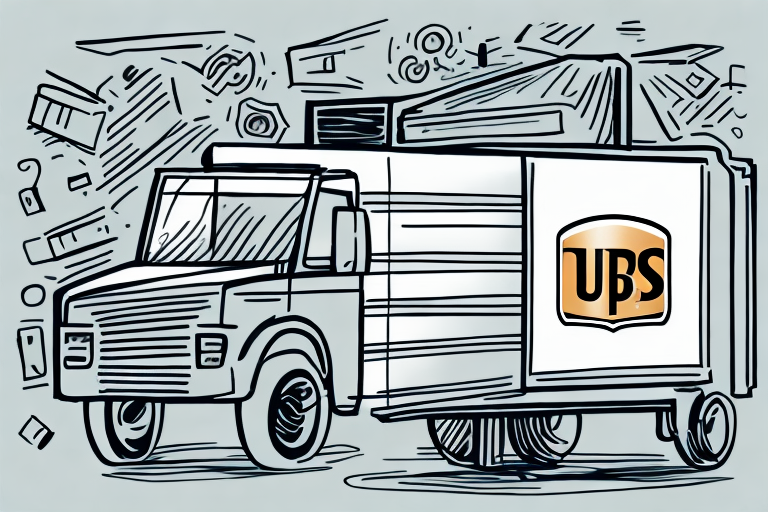If you're an Amazon seller, shipping costs can make a significant impact on your profits. UPS is one of the many carriers available for Amazon sellers and their shipping needs, but understanding the rates and how they work can be confusing. In this article, we will discuss the different factors that determine UPS shipping rates for Amazon sellers and how to calculate shipping costs. We will also cover the benefits and drawbacks of using UPS for Amazon shipping, how to negotiate better rates, and tips for reducing shipping costs.
How UPS shipping rates impact Amazon sellers
UPS shipping rates can have a direct impact on an Amazon seller's profits. The cost of shipping can impact the price of the product, which can impact the seller's competitive edge. Higher shipping fees also reduce the likelihood of a customer making a purchase, which can result in lost sales and lower profits. It's essential for Amazon sellers to understand how UPS shipping rates work and to ensure that they are getting the best rates possible.
One way for Amazon sellers to reduce their shipping costs is to take advantage of UPS's discounted rates for high-volume shippers. This can be achieved by negotiating with UPS directly or by using a third-party shipping software that offers discounted rates. Additionally, sellers can consider using alternative shipping carriers, such as USPS or FedEx, to compare rates and find the most cost-effective option for their business.
The factors that determine UPS shipping rates for Amazon sellers
There are several factors that contribute to the UPS shipping rates for Amazon sellers. These include package weight and dimensions, shipping distance, delivery speed, and any additional services selected, such as signature confirmation or insurance. The package's destination also impacts the shipping rates, including the country, city, and zip code. Additionally, UPS offers different levels of service, and the rates vary based on the selected level of service.
Another factor that can impact UPS shipping rates for Amazon sellers is the time of year. During peak holiday seasons, shipping rates may increase due to high demand and limited availability. It's important for sellers to plan ahead and factor in these potential rate increases when setting their prices and shipping options.
Furthermore, UPS offers discounts for high-volume shippers, which can help reduce shipping costs for Amazon sellers who ship frequently. These discounts are based on the total volume of packages shipped over a certain period of time and can be negotiated with UPS directly. It's worth exploring these options to see if they can help lower shipping costs and increase profitability for Amazon sellers.
How to calculate your Amazon shipping costs using UPS rates
Calculating shipping costs using UPS rates can seem daunting at first, but there are tools available to make the process easier. Amazon provides a shipping calculator within the seller account that incorporates UPS rates. To calculate shipping rates manually, estimate the package's weight and dimensions and enter that information into UPS's rate calculator. The calculator will provide an estimate of the shipping costs based on the selected UPS service level. Keep in mind that these rates are estimates and will not be exact until the package is actually shipped.
It's important to note that UPS rates can vary depending on the destination and the time of year. During peak holiday seasons, rates may be higher due to increased demand. Additionally, UPS offers discounts for high-volume shippers, so it may be worth exploring if you plan on shipping a large number of packages through Amazon.
Another factor to consider when calculating shipping costs is the packaging materials. UPS offers a variety of packaging options, including boxes, envelopes, and tubes, which can affect the overall weight and dimensions of the package. It's important to choose the appropriate packaging for your item to ensure it arrives safely and to avoid any additional fees for oversized or overweight packages.
The benefits of using UPS for Amazon shipping
There are several benefits to using UPS for Amazon shipping. UPS offers a vast network of shipping options, including ground and air shipping, which can accommodate various shipping needs. Their tracking system is advanced, which can provide sellers and customers with real-time updates on the package's location. UPS also has a reliable reputation for on-time delivery and offers additional services such as signature confirmation and insurance to protect sellers and customers in case of theft or damage.
In addition to these benefits, UPS also offers competitive pricing for their shipping services. They have a range of pricing options, including flat-rate and volume-based pricing, which can help sellers save money on shipping costs. UPS also provides discounts for Amazon sellers who use their services frequently, which can further reduce shipping expenses. By using UPS for Amazon shipping, sellers can save money while still providing their customers with reliable and efficient shipping options.
The drawbacks of using UPS for Amazon shipping
While there are benefits to using UPS, there are also drawbacks to consider. UPS rates can be higher than other carriers, which can eat into profits for Amazon sellers. Additionally, some customers may have preferences for other carriers, and offering only UPS shipping may deter potential buyers. UPS is also known to be strict on package weight and dimensions, and additional fees may be added if these are not accurately estimated before shipping.
Another drawback of using UPS for Amazon shipping is the potential for delays or lost packages. While UPS has a good track record for timely delivery, there are instances where packages may be delayed due to weather conditions or other unforeseen circumstances. This can lead to unhappy customers and negative reviews for Amazon sellers.
Furthermore, UPS may not be the best option for international shipping. The rates for international shipping can be significantly higher than other carriers, and there may be additional customs fees and taxes that need to be paid. This can make it difficult for Amazon sellers to compete with other sellers who offer more affordable international shipping options.
How to negotiate better UPS rates for your Amazon business
It's essential for Amazon sellers to negotiate better UPS rates to increase profits. Negotiations can be done directly with UPS or through a third-party shipping broker. Consider shipping volume, package size and weight, and distance when negotiating rates with UPS. It's also essential to research the rates offered by other carriers and use those rates as leverage when negotiating with UPS.
Another important factor to consider when negotiating UPS rates is the type of products you are shipping. Some products may require special handling or packaging, which can increase shipping costs. It's important to communicate these requirements with UPS and negotiate rates accordingly. Additionally, consider using UPS's online tools and resources to optimize your shipping process and reduce costs, such as their shipping calculator and package pickup options.
Comparing UPS shipping rates to other carriers for Amazon sellers
It's essential to compare UPS shipping rates to those offered by other carriers to ensure that you're getting the best rates for your Amazon business. Research other carriers, such as FedEx and USPS, and compare their rates to UPS rates. Consider the carrier's reputation, reliability, and additional services when making a decision.
Another factor to consider when comparing shipping rates is the destination of your packages. Some carriers may offer better rates for certain regions or countries, while others may have higher fees for international shipping. It's important to take into account the specific needs of your business and your customers when choosing a carrier.
Tips for reducing your Amazon shipping costs with UPS
Reducing shipping costs can increase profits for Amazon sellers. Consider using UPS's online shipping tools, such as UPS My Choice and UPS Marketplace Shipping, to streamline the shipping process and save money. Utilize UPS's packaging options, such as their free shipping supplies, to reduce the package's size and weight. Consider adjusting delivery speed to balance cost and the customer's expectations. Finally, optimizing package weight and dimensions can reduce fees and save money.
Another way to reduce Amazon shipping costs with UPS is to take advantage of their discounted rates for high-volume shippers. If you regularly ship a large number of packages, you may be eligible for lower rates through UPS's volume discount program. Additionally, consider consolidating multiple orders into one shipment to save on shipping costs. This can be especially beneficial for customers who place multiple orders with your store. By combining orders, you can reduce the number of packages you need to ship and save on shipping fees.
Common mistakes to avoid when using UPS for Amazon shipping
There are common mistakes that Amazon sellers make when using UPS for shipping. First, not accurately estimating package weight and dimensions can result in additional fees. Not researching and negotiating shipping rates can result in higher shipping costs. Failing to track packages and update customers on delivery status can hurt the customer experience and result in negative feedback. These mistakes can be costly and impact the seller's bottom line.
Understanding UPS shipping rates is crucial for Amazon sellers. By considering factors such as weight and dimensions, distance, delivery speed, and additional services, sellers can calculate shipping costs and negotiate better rates. Additionally, optimizing packaging and streamlining the shipping process can reduce shipping costs and increase profits.
Another common mistake that Amazon sellers make when using UPS for shipping is not properly insuring their packages. In the event of lost or damaged packages, not having insurance can result in significant financial losses for the seller. It is important to understand the insurance options available through UPS and to choose the appropriate level of coverage for each shipment. Additionally, properly labeling packages with clear and accurate information can help ensure that packages are delivered to the correct address and reduce the risk of lost or delayed shipments.






















